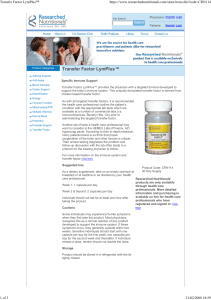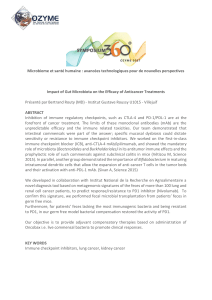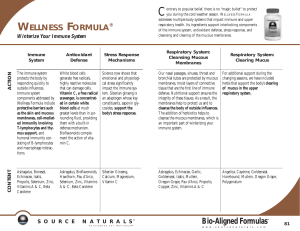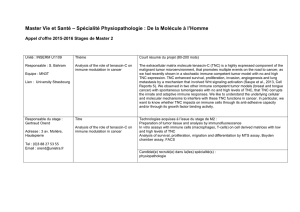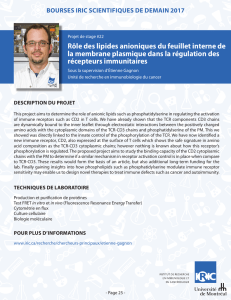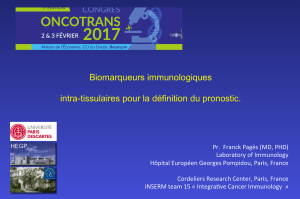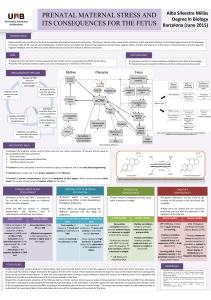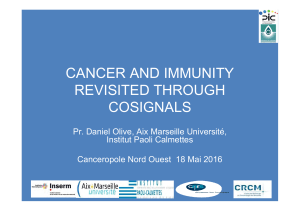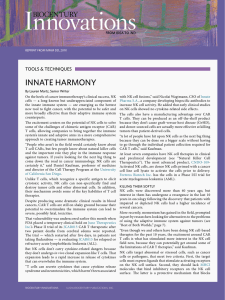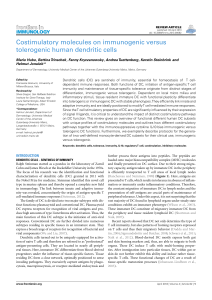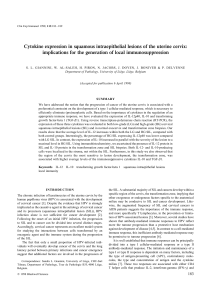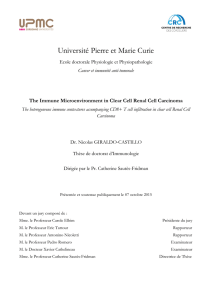and studies of their immune status and of the response... their immune cells to various stimuli proved that the
publicité
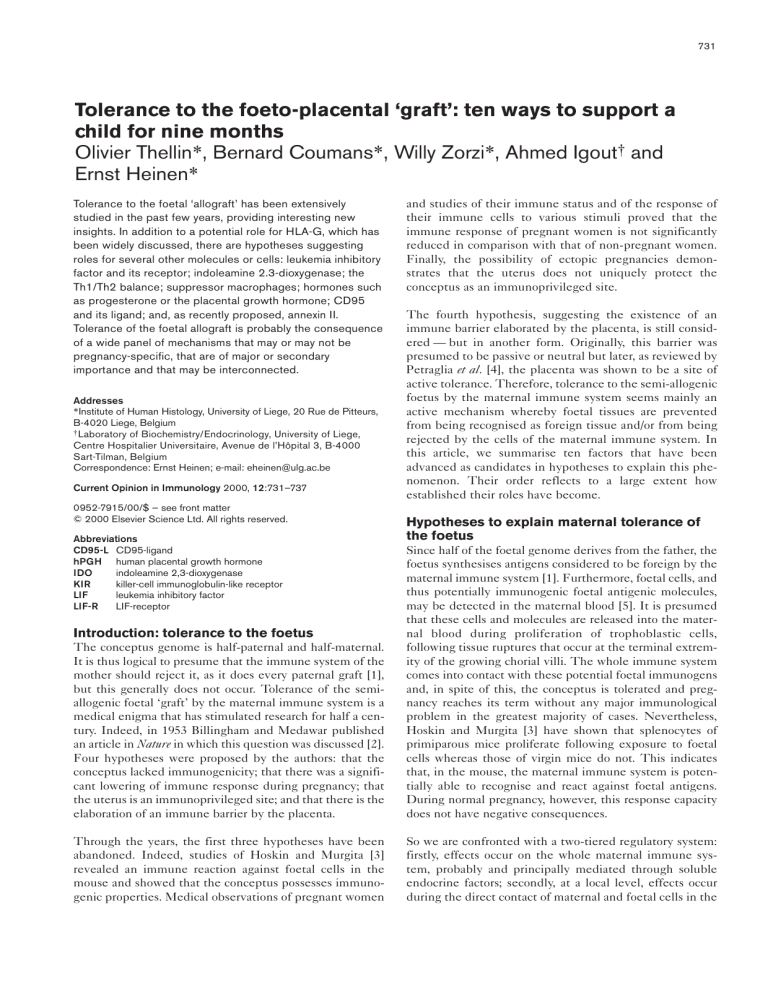
731 Tolerance to the foeto-placental ‘graft’: ten ways to support a child for nine months Olivier Thellin*, Bernard Coumans*, Willy Zorzi*, Ahmed Igout† and Ernst Heinen* Tolerance to the foetal ‘allograft’ has been extensively studied in the past few years, providing interesting new insights. In addition to a potential role for HLA-G, which has been widely discussed, there are hypotheses suggesting roles for several other molecules or cells: leukemia inhibitory factor and its receptor; indoleamine 2.3-dioxygenase; the Th1/Th2 balance; suppressor macrophages; hormones such as progesterone or the placental growth hormone; CD95 and its ligand; and, as recently proposed, annexin II. Tolerance of the foetal allograft is probably the consequence of a wide panel of mechanisms that may or may not be pregnancy-specific, that are of major or secondary importance and that may be interconnected. Addresses *Institute of Human Histology, University of Liege, 20 Rue de Pitteurs, B-4020 Liege, Belgium † Laboratory of Biochemistry/Endocrinology, University of Liege, Centre Hospitalier Universitaire, Avenue de l’Hôpital 3, B-4000 Sart-Tilman, Belgium Correspondence: Ernst Heinen; e-mail: [email protected] Current Opinion in Immunology 2000, 12:731–737 0952-7915/00/$ — see front matter © 2000 Elsevier Science Ltd. All rights reserved. Abbreviations CD95-L CD95-ligand hPGH human placental growth hormone IDO indoleamine 2,3-dioxygenase KIR killer-cell immunoglobulin-like receptor LIF leukemia inhibitory factor LIF-R LIF-receptor and studies of their immune status and of the response of their immune cells to various stimuli proved that the immune response of pregnant women is not significantly reduced in comparison with that of non-pregnant women. Finally, the possibility of ectopic pregnancies demonstrates that the uterus does not uniquely protect the conceptus as an immunoprivileged site. The fourth hypothesis, suggesting the existence of an immune barrier elaborated by the placenta, is still considered — but in another form. Originally, this barrier was presumed to be passive or neutral but later, as reviewed by Petraglia et al. [4], the placenta was shown to be a site of active tolerance. Therefore, tolerance to the semi-allogenic foetus by the maternal immune system seems mainly an active mechanism whereby foetal tissues are prevented from being recognised as foreign tissue and/or from being rejected by the cells of the maternal immune system. In this article, we summarise ten factors that have been advanced as candidates in hypotheses to explain this phenomenon. Their order reflects to a large extent how established their roles have become. Hypotheses to explain maternal tolerance of the foetus The conceptus genome is half-paternal and half-maternal. It is thus logical to presume that the immune system of the mother should reject it, as it does every paternal graft [1], but this generally does not occur. Tolerance of the semiallogenic foetal ‘graft’ by the maternal immune system is a medical enigma that has stimulated research for half a century. Indeed, in 1953 Billingham and Medawar published an article in Nature in which this question was discussed [2]. Four hypotheses were proposed by the authors: that the conceptus lacked immunogenicity; that there was a significant lowering of immune response during pregnancy; that the uterus is an immunoprivileged site; and that there is the elaboration of an immune barrier by the placenta. Since half of the foetal genome derives from the father, the foetus synthesises antigens considered to be foreign by the maternal immune system [1]. Furthermore, foetal cells, and thus potentially immunogenic foetal antigenic molecules, may be detected in the maternal blood [5]. It is presumed that these cells and molecules are released into the maternal blood during proliferation of trophoblastic cells, following tissue ruptures that occur at the terminal extremity of the growing chorial villi. The whole immune system comes into contact with these potential foetal immunogens and, in spite of this, the conceptus is tolerated and pregnancy reaches its term without any major immunological problem in the greatest majority of cases. Nevertheless, Hoskin and Murgita [3] have shown that splenocytes of primiparous mice proliferate following exposure to foetal cells whereas those of virgin mice do not. This indicates that, in the mouse, the maternal immune system is potentially able to recognise and react against foetal antigens. During normal pregnancy, however, this response capacity does not have negative consequences. Through the years, the first three hypotheses have been abandoned. Indeed, studies of Hoskin and Murgita [3] revealed an immune reaction against foetal cells in the mouse and showed that the conceptus possesses immunogenic properties. Medical observations of pregnant women So we are confronted with a two-tiered regulatory system: firstly, effects occur on the whole maternal immune system, probably and principally mediated through soluble endocrine factors; secondly, at a local level, effects occur during the direct contact of maternal and foetal cells in the Introduction: tolerance to the foetus 732 Commentary Figure 2 Figure 1 (a) NK cell KIR Endometrium Maternal part of the placenta Negative signal Blastocyst LIF HLA-G Foetal part of the placenta Syncytiotrophoblast Mesenchyme LIF-R Uterine cavity (b) Decidua Maternal part of the placenta Current Opinion in Immunology Blood Th2 LIF A potential role of HLA-G in tolerance to the foetus. HLA-G, which is expressed specifically by the syncytiotrophoblast, may inhibit maternal NK cells by binding their KIRs. LIF-R placenta, principally through cellular contacts, or paracrine and autocrine soluble factors. The ten factors that we outline below, and the resulting hypotheses concerning their role in the phenomenon of tolerance to the foetal allograft, seem to implicate different mechanisms working in synergy. HLA-G expression by the trophoblast In humans, the syncytiotrophoblast, which constitutes the foetal syncytial layer isolating the foetal tissues from the maternal tissues, expresses a very particular set of MHC class I molecules. Indeed, HLA-A and HLA-B are not presented by the syncytiotrophoblastic cells whereas HLA-C seems weakly expressed [6,7]. On the other hand, these cells express HLA-G ([8]; see also Update); this class I molecule is encountered only on the syncytiotrophoblast and is nearly monomorphic — only two forms of this molecule are currently known. Recently, HLA-G has been found to bind the KIRs (killer-cell immunoglobulin-like receptors) of NK cells, as the other HLA molecules do. This interaction appears to block the cytotoxicity of these cells (Figure 1) and may contribute to the tolerance of the conceptus by reducing NK cell activity [9]. The nearly monomorphic status of HLA-G suggests a general inhibition of NK cells, independent of the parental genomes. Leukemia inhibitory factor and its receptor The maternal endometrium synthesises and secretes a hydrosoluble molecule called leukemia inhibitory factor (LIF) following a menstrual cycle related to the progesterone cycle [10]. During implantation, the endometrium secretes LIF whereas the blastocyst expresses at its surface the LIF-receptor (LIF-R) [11,12] (Figure 2a). This is Growth and differentiation of trophoblasts ? Syncytiotrophoblast Mesenchyme Foetal part of the placenta Current Opinion in Immunology A potential role of LIF and its receptor in tolerance to the foetus. (a) During implantation, LIF is secreted by the endometrium and allows the LIF-R-expressing blastocyst to implant. (b) During pregnancy, LIF is synthesised by the decidua and Th2 cells. Its binding to syncytiotrophoblastic LIF-R could help the growth and differentiation of the trophoblast. absolutely required for blastocyst implantation. During pregnancy, LIF is synthesised by the decidua — the maternal part of the placenta — and by Th2 lymphocytes whereas the syncytiotrophoblast expresses LIF-R [13] (Figure 2b). The exact function of the LIF/LIF-R molecules during pregnancy is still unknown but the binding of LIF on its receptor might favour trophoblastic growth and differentiation [14]. This mechanism is also closely related to other immune mechanisms implicated in the foetomaternal tolerance, such as the Th1/Th2 balance and regulation by progesterone. Indoleamine 2,3-dioxygenase Indoleamine 2,3-dioxygenase (IDO) is an enzymatic protein that catabolises tryptophan. This enzyme is synthesised and secreted by the syncytiotrophoblast and has been shown to be essential for the success of pregnancy in the mouse [15,16]. A proposed explanation for its role in tolerance of the foetus is that IDO could act by catalysing tryptophan destruction in maternal immune cells that are localised in the placental area; this tryptophan deprivation might reduce or inhibit some immune cell responses (Figure 3). Foetal tolerance mechanisms Thellin et al. Figure 3 733 Figure 4 Maternal immune cell Th1 Cell inactivaton Lack of tryptophan Maternal part of the placenta Th2 Progesterone Cytokines Syncytiotrophoblast IDO Mesenchyme Syncytiotrophoblast Mesenchyme Foetal part of the placenta Current Opinion in Immunology A potential role of IDO in tolerance to the foetus. Syncytiotrophoblastic IDO catabolises tryptophan and this may inhibit maternal immune cells at the placenta. The Th1/Th2 balance Th0 precursor cells differentiate into Th1 or Th2 cells in response to signals given during antigen presentation. In the presence of IL-12 and IFN-γ, Th0 cells will differentiate into Th1 cells; in contrast, Th0 cells become Th2 cells after contact with IL-4 [17]. The Th1/Th2 balance in the placenta has been studied and results have shown that a Th1-type reaction in the placenta, which mainly generates inflammatory responses, is often correlated with miscarriages whereas a Th2 cell induction generates noninflammatory responses that are compatible with the survival of the foetus [13,18–20]. Th1 and Th2 cells exert different actions. Th1 cells synthesise IL-2 and IFN-γ whereas Th2 cells preferentially synthesise IL-4, IL-5, IL-6, IL-9, IL-10 (see also Update) and IL-13. Th1 and Th2 cells also share the production of some cytokines like IL-3, TNF and GM-CSF. T cells are, however, not the only producers of cytokines. Notably here, syncytiotrophoblasts and cytotrophoblasts are able to produce cytokines; these cells can also influence cytokine production, by acting on Th1/Th2 balance [21,22]. They generally direct to a Th2-type response in the peri-implantatory site of the endometrium [23] and during pregnancy (Figure 4) [24]. Suppressor macrophages Placental macrophages that protect the immunologically privileged embryo occur naturally [25]. Today these suppressor macrophages are considered to be ‘alternatively’ activated macrophages that are able to exert anti-inflammatory influences in various sites of the body. In contrast to ‘classically’ activated macrophages that have pro-inflammatory potency, for example those induced by IFN-γ or lipopolysaccharides, the alternatively activated macrophages Maternal part of the placenta Foetal part of the placenta Current Opinion in Immunology A potential role of the Th1/Th2 balance in tolerance to the foetus. A successful pregnancy is more often correlated with a Th2- than with a Th1-type neighbourhood. Besides, the syncytiotrophoblast secretes hormones and various cytokines that influence the Th1/Th2 balance, mainly towards Th2. produce little to no free oxygen derivatives but produce more of the anti-inflammatory molecules IL-10 and IL-1-Rantagonist (see [26] for a review). Hormones Numerous hormones and cytokines are present and active at the placenta (for a review, see [4]). They act on the trophoblastic tissues in many ways and some of them modulate immune functions. An important molecule is progesterone, which is synthesised in large quantities by the placenta and is able to lower the immune response [27]. The precise effects of this hormone on foetal tolerance have been described. Progesterone is able to promote LIF synthesis by the endometrium [10] and to displace the Th1/Th2 balance (see above) towards Th2 [28] (Figure 4); however progesterone is not the only hormone able to act on the immune system. Growth hormone appears likewise, in some rodent species, to influence certain functions of the immune system. It is important to note that the human placenta synthesises a particular growth hormone, human placental growth hormone (hPGH), differing in only 13 amino acids from pituitary growth hormone (hGH-N); hPGH replaces hGH-N in the maternal blood during the second half of the pregnancy [29,30]. hPGH is abundantly produced during pregnancy and could play an active role in foeto-placental tolerance by acting on the maternal immune system. Experiments in which hGH-N or hPGH were introduced at physiological concentrations into the culture medium of lymphoid cells indicated that the actions of hGH-N and hPGH on cell proliferation and the production of cytokines are equivalent [31]. Because of its structural, binding and physiological differences relative to hGH-N, it is possible that hPGH-specific effects may be found in the future, both in vitro and in vivo. 734 Commentary Figure 5 Soluble form of CD95-L Maternal part of the placenta CD95 Ap op t os is No apparent apoptosis Activated T cell CD95-L Syncytiotrophoblast Mesenchyme Foetal part of the placenta Current Opinion in Immunology A potential role of CD95 and its ligand in tolerance to the foetus. Syncytiotrophoblastic CD95-L binds CD95 on maternal immune cells, which triggers their apoptosis; in contrast, binding of CD95 to its ligand on the syncytiotrophoblast does not appear to cause apoptosis to a detrimental level. CD95 and its ligand The CD95/CD95-ligand (CD95-L) system is an apoptotic pathway widely used in the immune system during lymphopoiesis and immunopoiesis. It is mainly implicated in regulation of cellular turnover, tumor cell elimination, antiviral responses and protection of particular tissues against potential danger represented mainly by activated lymphocytes [32]. It is also active during clonal deletion of autoimmune cells inside the central and peripheral lymphoid organs and is involved in the cytolytic pathways of NK cells, Th1 cells and cytotoxic T cells. This cytolysis occurs in parallel with perforin production by NK cells and cytotoxic T cells. This system functions as follows: CD95-L is expressed by effector cells whereas the target cells express CD95. For protection of particular tissues, CD95-L is expressed by the cells that delineate the immunoprivileged site. For example, CD95/CD95-L are active in the protection of certain parts of the eye [33,34] and CD95-L has been detected on the surface of rat Sertoli cells [35] and, more recently, inside human testis [32]. We and other groups have proposed that CD95-L is expressed by trophoblastic cells and is able to kill the activated, CD95+ blood cells that enter into contact with the conceptus (Figure 5). TNF/TNF-R apoptotic system, which is also present at the placenta [4], could be involved in tolerance to the foetus. By in vivo observation, Jerzak et al. [41] detected apoptotic T lymphocytes in human decidua during the first trimester; this supports our hypothesis related to the active elimination of potentially dangerous T cells by trophoblastic cells. Furthermore, proteolysis of cell surface CD95-L, mediated by a membrane metalloproteinase, produces a 26 kDa soluble form of the CD95-L [42–44]. This molecule is biologically active [45] and could also trigger apoptosis of immune cells near to, or coming into contact with, the foetal cells. Annexin II Annexin II is a member of a family of glycoproteins that bind to negatively charged phospholipids in a calciumdependent manner. Annexins are membrane-associated proteins that are expressed in both normal and malignant cells and can also be secreted by the placenta [46]. Recently, Aarli and Matre [47] showed that annexin II can partially inhibit lymphoproliferation of, and IgG and IgM secretion by, maternal immune cells (Figure 6). Thus, this molecule might be involved in protection of the foetus against the maternal immune system. Lowered complement activity A way commonly used by the immune system to kill foreign or cancerous cells is to activate the complement system. Certain antibody isotypes bind to their membrane antigen and initiate the complement cascade, leading to the assembly of the membrane attack complex; this creates a hole in the target cell, which then dies quickly. So, recognition of paternal antigens on the surface of syncytiotrophoblast could activate the complement cascade, resulting in death of trophoblastic cells. Certain molecules are able to reduce this phenomenon, either by blocking the binding sites of the complement to antibodies (e.g. membrane complement protein [MCP] does this) [48] or by raising the complement destruction rate (e.g. decay accelerating factor [DAF] does this) [49] (Figure 7). These molecules have systemic effects. In the placenta, they could reduce the ability of complement to kill trophoblastic cells that bear paternal antigens (see also Update). Hidden trophoblastic antigens In parallel with other groups [32,36], we have indeed shown that trophoblastic cells synthesise CD95-L in vivo and in vitro [37]. Cultured trophoblastic cells are able to induce apoptosis in blood T cells expressing CD95 [38]. It is notable that trophoblastic cells also express CD95 ([39]; O Thellin, B Coumans, E Heinen, unpublished data) but apparently do so without full apoptotic consequences for these cells [40]. This CD95 expression could play a role in limiting the proliferation of the trophoblast. Our results also suggest that only a part of the observed apoptosis occurs effectively via the CD95/CD95-L pathway; the It has been suggested that trophoblastic antigens expressed by the syncytiotrophoblast are camouflaged, thus avoiding the maternal immune system [50]; however, this hypothesis is very speculative. There are numerous possibilities for the mechanism of camouflage, including foetal-antigenspecific blocking antibodies and fibrinoid material or sialomucines, which may ‘cover’ foetal antigens. Anti-idiotypic antibodies that block antibodies directly aimed at the foetal antigens could also be implicated [51]. Hiding of the trophoblastic antigens suggests a reduction of the antigenicity of the syncytiotrophoblast. Foetal tolerance mechanisms Thellin et al. Figure 6 735 Figure 7 Complement Lymphocyte Inhibition of IgG secretion and cell proliferation Maternal part of the placenta DAF MCP Maternal part of the placenta PLn Annexin II Syncytiotrophoblast Foetal tissues Antibody Foetal part of the placenta Syncytiotrophoblast Mesenchyme Foetal part of the placenta Current Opinion in Immunology Current Opinion in Immunology A potential role of annexin II in tolerance to the foetus. Syncytiotrophoblastic annexin II inhibits functions of maternal lymphocytes, for example IgG secretion and cell proliferation, after binding to negatively charged phospholipids (PLn). A potential role of complement-inhibitory mechanisms in tolerance to the foetus. Complement availability could be reduced by its binding to membrane complement protein (MCP) or by its destruction by decay accelerating factor (DAF). Conclusions As reviewed here, many very different mechanisms play a part in foeto-placental tolerance; however, their relative importance in other aspects of pregnancy may differ. Indeed, progesterone and LIF/LIF-R are necessary for blastocyst implantation. Progesterone also plays a major role during implantation and gestation; it can act locally and at a distance. Other mechanisms, such as those involving IDO, HLA-G, CD95/CD95-L and the complement-inhibiting molecules exert their effects primarily on the immune system. The factors outlined above involve one molecule that is only found at the placenta (HLA-G) whereas other mechanisms act elsewhere in the organism (complement regulation, IDO, Th1/Th2, certain hormones, CD95/CD95-L and annexin II; see also Update). These mechanisms mainly work in parallel but some of them could also help to restrain negative effects of other ones. For example, CD95-L acts as chemotactant for the granulocytes [52] (this could explain how these cells are mobilized against CD95-L-expressing grafts [53,54]) whereas pituitary growth hormone has been shown to inhibit the chemotaxis of neutrophils [55]. hPGH, which is produced in high amounts by the foetal part of the placenta, may protect the foetal tissues against an invasion by maternal neutrophils that are attracted by CD95-L. The redundant mechanisms that are involved in tolerance to the conceptus allow successful pregnancy even when women are deficient for one of these mechanisms. In summary, maternal tolerance of the foeto-placental graft is the result of the integration of numerous mechanisms of various origins and modes of action; however only some of these mechanisms may really be important for the success of the pregnancy. Update Recently, the anti-inflammatory cytokine IL-10, produced notably in the placenta, has been shown to increase HLA-G synthesis in vitro in peripheral-blood monocytes and in trophoblast organ culture, and is thus a good candidate as a stimulator of HLA-G synthesis in the trophoblast in vivo [56]. Regulation of complement could be more important than previously expected, as mice with a knockout of Crry (a rodent-specific complement regulator) die in utero. These embryos appear to contain C3 deposited on the placenta, indicating complement activation ([57]; see [58] for review). References 1. Bouma GS, van Caubergh P, van Bree SP, Castelli-Visser RM, Witvliet MD, van der Meer-Prins EM, van Rood JJ, Claas FH: Pregnancy can induce priming of cytotoxic T lymphocytes specific for paternal HLA antigens that is associated with antibody formation. Transplantation 1996, 62:672-678. 2. Billingham RE, Medawar PB: ‘Actively acquired tolerance’ of foreign cells. Nature 1953, 172:603-606. 3. Hoskin DW, Murgita RA: Specific maternal anti-fetal lymphoproliferative responses and their regulation by natural immunosuppressive factors. Clin Exp Immunol 1989, 76:262-267. 4. Petraglia F, Florio P, Nappi C, Genazzani AR: Peptide signaling in human placenta and membranes: autocrine, paracrine, and endocrine mechanisms. Endocr Rev 1996, 17:156-186. 5. Reading JP, Huffman JL, Wu JC, Palmer FT, Harton GL, Sisson ME, Keyvanfar K, Gresinger TH, Cochrane WJ, Fallon LA et al.: Nucleated erythrocytes in maternal blood: quantity and quality of fetal cells in enriched populations. Human Reprod 1995, 10:2510-2515. 6. King A, Boocock C, Sharley AM, Gardner L, Beretta A, Siccardi AG, Loke YW: Evidence for the expression of HLA-C class I mRNA and protein by human first trimester trophoblast. J Immunol 1996, 156:2068-2076. 7. Hammer A, Hutter H, Dohr G: HLA class I expression on the materno-fetal interface. Am J Reprod Immunol 1997, 38:150-157. 8. Kovats S, Main EK, Librach C, Stubblebine M, Fisher SJ, Demars R: A class I antigen, HLA-G, expressed in human trophoblasts. Science 1990, 248:220-223. 736 9. Commentary Moreau P, Paul P, Rouas-Freiss N, Kirszenbaum M, Dausset J, Carosella ED: Molecular and immunologic aspects of the nonclassical HLA class I antigen HLA-G: evidence for an important role in the maternal tolerance of the fetal allograft. Am J Reprod Immunol 1998, 40:136-144. 10. Ace CI, Okulicz WC: Differential gene regulation by estrogen and progesterone in the primate endometrium. Mol Cell Endocrinol 1995, 115:95-103. 11. Charnock-Jones DS, Sharkey AM, Fenwick P, Smith SK: Leukemia inhibitory factor mRNA concentration peaks in human endometrium at the time of implantation and the blastocyst contains mRNA for the receptor at this time. J Reprod Fertil 1994, 101:421-426. 12. Senturk LM, Arici A: Leukemia inhibitory factor in human reproduction. Reprod Immunol 1998, 39:144-151. 13. Piccinni MP, Beloni L, Livi C, Maggi E, Scarselli G, Romagnani S: Defective production of both leukemia inhibitory factor and type 2 T-helper cytokines by decidual T cells in unexplained recurrent abortions. Nat Med 1998, 4:1020-1024. 14. Kojima K, Kanzaki H, Iwai M, Hatayama H, Fujimoto M, Narukawa S, Higuchi T, Kaneko Y, Mori T, Fujita J: Expression of leukaemia inhibitory factor (LIF) receptor in human placenta: a possible role for LIF in the growth and differentiation of trophoblasts. Human Reprod 1995, 10:1907-1911. 15. Munn DH, Zhou M, Attwood JT, Bondarev I, Conway SJ, Marshall B, Brown C, Mellor AL: Prevention of allogeneic fetal rejection by tryptophan catabolism. Science 1998, 281:1191-1193. 16. Mellor AL, Munn DH: Tryptophan catabolism and T-cell tolerance: immunosuppression by starvation? Immunol Today 1999, 20:469-473. 17. Palmer EM, Seventer GA: Human T helper cell differentiation is regulated by the combined action of cytokines and accessory cell-dependent costimulatory signals. J Immunol 1997, 158:2654-2662. 18. Wegmann TG, Lin H, Guilbert L, Mosmann TR: Bidirectional cytokine interactions in the maternal-fetal relationship: is successful pregnancy a TH2 phenomenon? Immunol Today 1993, 14:353-356. 19. Hill JA, Polgar K, Anderson DJ: T-helper 1-type immunity to trophoblast in women with recurrent spontaneous abortion. JAMA 1995, 273:1933-1936. 20. Raghupathy R: Th1-type immunity is incompatible with successful pregnancy. Immunol Today 1997, 18:478-482. 21. Krasnow JS, Tollerud DJ, Naus G, Deloia JA: Endometrial Th2 cytokine expression throughout the menstrual cycle and early pregnancy. Human Reprod 1996, 11:1747-1754. 22. de Moraes-Pinto MI, Vince GS, Flanagan BF, Hart CA, Johnson PM: Localization of IL-4 receptors in the human term placenta, decidua and amniochorionic membranes. Immunology 1997, 90:87-94. 23. Lim KJ, Odukoya OA, Ajjan RA, Li TC, Weetman AP, Cooke ID: Profile of cytokine mRNA expression in peri-implantation human endometrium. Mol Hum Reprod 1998, 4:77-81. 24. Lin HY, Lordish H: Receptors for the TGF-b superfamily: multiple polypeptides and serine/threonine kinases. Trends Cell Biol 1993, 3:14-19. 25. Chang MD, Pollard JW, Khalili H, Goyert SM, Diamond B: Mouse placental macrophages have a decreased ability to present antigen. Proc Natl Acad Sci USA 1993, 90:462-466. 26. Goerdt S, Orfanos CE: Other functions, other genes: alternative activation of antigen-presenting cells. Immunity 1999, 10:137-142. 27. Siiteri PK, Stites DP: Immunologic and endocrine interrelationships in pregnancy. Biol Reprod 1982, 26:1-14. 28. Piccinni MP, Giudizi MG, Biagiotti R, Beloni L, Giannarini L, Sampognaro S, Parronchi P, Manetti R, Annunziato F, Livi C et al.: Progesterone favours the development of human T helper cells producing Th2-type cytokines and promotes both IL-4 production and membrane CD30 expression in established Th1 cell clones. J Immunol 1995, 155:128-133. 29. Hennen G, Frankenne F, Closset J, Gomez F, Pirens G, el Khayat N: A human placental GH: increasing levels during second half of pregnancy with pituitary GH suppression as revealed by monoclonal antibody radioimmunoassays. Int J Fertil 1985, 30:27-33. 30. Frankenne F, Rentier-Delrue F, Scippo ML, Martial J, Hennen G: Expression of the growth hormone variant gene in human placenta. J Clin Endocrinol 1987, 64:635-637. 31. Thellin O, Coumans B, Devos S, Hooghe-Peters EL, Zorzi W, Igout A, Heinen E, Hooghe R: Limited effects of placental and pituitary growth hormone on cytokine expression in vitro. Eur Cytokine Netw 2000, in press. 32. Xerri L, Devilard E, Hassoun J, Mawas C, Birg F: Fas ligand is not only expressed in immune privileged human organs but is also coexpressed with Fas in various epithelial tissues. Mol Pathol 1997, 50:87-91. 33. Griffith TS, Brunner T, Fletcher SM, Green DR, Ferguson TA: Fas ligand-induced apoptosis as a mechanism of immune privilege. Science 1995, 270:1189-1192. 34. Wilson SE, Li Q, Weng J, Barry-Lane PA, Jester JV, Liang Q, Wordinger RJ: The Fas-Fas ligand system and other modulators of apoptosis in the cornea. Invest Ophthalmol Vis Sci 1996, 37:1582-1592. 35. Bellgrau D, Gold D, Selawry H, Moore J, Franzusoff A, Duke RC: A role for CD95 ligand in preventing graft rejection. Nature 1995, 377:630-632. 36. Bamberger AM, Schulte HM, Thuneke I, Erdmann I, Bamberger CM, Asa SL: Expression of the apoptosis-inducing Fas ligand (FasL) in human first and third trimester placenta and choriocarcinoma cells. J Clin Endocrinol Metab 1997, 82:3173-3175. 37. Zorzi W, Thellin O, Coumans B, Melot F, Hennen G, Lakaye B, Igout A, Heinen E: Demonstration of the expression of CD95 ligand transcript and protein in human placenta. Placenta 1998, 19:269-277. 38. Coumans B, Thellin O, Zorzi W, Melot F, Bougoussa M, Melen L, Zorzi D, Hennen G, Igout A, Heinen E: Lymphoid cell apoptosis induced by trophoblastic cells: a model of active foeto-placental tolerance. J Immunol Methods 1999, 224:185-196. 39. Runic R, Lockwood CJ, Ma Y, Dipasquale B, Guller S: Expression of Fas ligand by human cytotrophoblasts: implications in placentation and fetal survival. J Clin Endocrinol Metab 1998, 81:3119-3122. 40. Payne SG, Smith SC, Davidge ST, Baker PN, Guilbert LJ: Death receptor Fas/Apo-1/CD95 expressed by human placental cytotrophoblasts does not mediate apoptosis. Biol Reprod 1999, 60:1144-1150. 41. Jerzak M, Kasprzycka M, Wierbicki P, Kotarski J, Gorski A: Apoptosis of T cells in the first trimester human decidua. Am J Reprod Immunol 1998, 40:130-135. 42. Suda T, Nagata S: Purification and characterization of the Fasligand that induces apoptosis. J Exp Med 1994, 179:873-879. 43. Mariani SM, Matiba B, Baumler C, Krammer PH: Regulation of cell surface APO-1/Fas (CD95) ligand expression by metalloproteases. Eur J Immunol 1995, 25:2303-2307. 44. Tanaka M, Suda T, Takahashi T, Nagata S: Expression of the functional soluble form of human Fas ligand in activated lymphocytes. EMBO J 1995, 14:1129-1135. 45. Liu QY, Rubin MA, Omene C, Lederman S, Stein CA: Fas ligand is constitutively secreted by prostate cancer cells in vitro. Clin Cancer Res 1998, 4:1803-1811. 46. Aarli A, Kristoffersen EK, Jensen TS, Ulvestad E, Matre R: Suppressive effect on lymphoproliferation in vitro by soluble annexin II released from isolated placental membranes. Am J Reprod Immunol 1997, 38:313-319. 47. Aarli A, Matre R: Suppression of immunoglobulin secretion by soluble annexin II. Scand J Immunol 1998, 48:522-526. 48. Johnson PM, Risk JM, Mwenda JM: Human trophoblast expression of retroviral like activity and CD46 (membrane cofactor protein, Hu Ly-m5 and H316 TLX antigen). In Reproductive Immunology. Edited by Mettler L, Billington WD. Amsterdam: Elsevier Science; 1990:125-131. Foetal tolerance mechanisms Thellin et al. 737 49. Holmes CH, Simpson KL, Wainwright SD, Tate CG, Houlihan JM, Sawyer IH, Rogers IP, Spring FA, Anstee DJ, Tanner MJ: Preferential expression of the complement regulatory protein decay accelerating factor at the fetomaternal interface during human pregnancy. J Immunol 1990, 144:3099-3105. 54. Takeuchi T, Ueki T, Nishimatsu H, Hajiwara T, Ishida T, Jishage K, Ueda O, Suzuki H, Li B, Moriyama N, Kitamura T: Accelerated rejection of Fas ligand-expressing heart grafts. J Immunol 1999, 162:518-522. 50. Scott MD, Murad KL: Cellular camouflage: fooling the immune system with polymers. Curr Pharm Des 1998, 4:423-438. 55. Fornari MC, Scolnik MP, Palacios MF, Intebi AD, Diez RA: Growth hormone inhibits normal B-cell differentiation and neutrophils’ chemotaxis in vitro. Int J Immunopharmacol 1994, 16:667-673. 51. Bonagura VR, Ma A, McDowell J, Lewison A, King DW, Suciu-Foca N: Anti-clonotypic autoantibodies in pregnancy. Cell Immunol 1987, 108:356-365. 56. Moreau P, Adrian-Cabestre F, Menier C, Guiard V, Gourand L, Dausset J, Carosella ED, Paul P: IL-10 selectively induces HLA-G expression in human trophoblasts and monocytes. Int Immunol 1999, 11:803-811. 52. Seino K, Iwabuchi K, Kayagaki N, Miyata R, Nagaoka I, Matsuzawa A, Fukao K, Yagita H, Okumura K: Chemotactic activity of soluble Fas ligand against phagocytes. J Immunol 1998, 161:4484-4488. 57. 53. Kang SM, Schneider DB, Lin Z, Hanahan D, Dichek DA, Stock PG, Baekkeskov S: Fas ligand expression in islets of Langerhans does not confer immune privilege and instead targets them for rapid destruction. Nat Med 1997, 3:738-743. 58. Morgan BP, Holmes CH: Immunology of reproduction: protecting the placenta. Curr Biol 2000, 10:R381-R383. Xu C, Mao D, Holers VM, Palance B, Cheng AM, Molina H: A critical role for murine complement regulator Crry in fetomaternal tolerance. Science 2000, 287:498-501.
